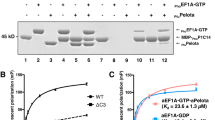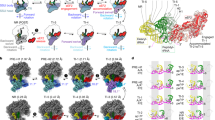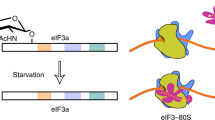Abstract
Lys34 of the conserved translation elongation factor P (EF-P) is post-translationally lysinylated by YjeK and YjeA—a modification that is critical for bacterial virulence. Here we show that the currently accepted Escherichia coli EF-P modification pathway is incomplete and lacks a final hydroxylation step mediated by YfcM, an enzyme distinct from deoxyhypusine hydroxylase that catalyzes the final maturation step of eukaryotic initiation factor 5A, the eukaryotic EF-P homolog.
This is a preview of subscription content, access via your institution
Access options
Subscribe to this journal
Receive 12 print issues and online access
$259.00 per year
only $21.58 per issue
Buy this article
- Purchase on Springer Link
- Instant access to full article PDF
Prices may be subject to local taxes which are calculated during checkout



Similar content being viewed by others
References
Glick, B.R. & Ganoza, M.C. Proc. Natl. Acad. Sci. USA 72, 4257–4260 (1975).
Glick, B.R., Chladek, S. & Ganoza, M.C. Eur. J. Biochem. 97, 23–28 (1979).
Ganoza, M.C. & Aoki, H. Biol. Chem. 381, 553–559 (2000).
Swaney, S. et al. J. Biomol. Screen. 11, 736–742 (2006).
Bailly, M. & de Crecy-Lagard, V. Biol. Direct 5, 3 (2010).
Kyrpides, N.C. & Woese, C.R. Proc. Natl. Acad. Sci. USA 95, 224–228 (1998).
Park, M.H., Nishimura, K., Zanelli, C.F. & Valentini, S.R. Amino Acids 38, 491–500 (2010).
Aoki, H. et al. FEBS J. 275, 671–681 (2008).
Yanagisawa, T., Sumida, T., Ishii, R., Takemoto, C. & Yokoyama, S. Nat. Struct. Mol. Biol. 17, 1136–1143 (2010).
Navarre, W.W. et al. Mol. Cell 39, 209–221 (2010).
Roy, H. et al. Nat. Chem. Biol. 7, 667–669 (2011).
Park, J.H. et al. J. Biol. Chem. 287, 2579–2590 (2012).
Behshad, E. et al. Biochemistry 45, 12639–12646 (2006).
Kaniga, K., Compton, M.S., Curtiss, R. III & Sundaram, P. Infect. Immun. 66, 5599–5606 (1998).
Bearson, S.M., Bearson, B.L. & Rasmussen, M.A. Appl. Environ. Microbiol. 72, 2829–2836 (2006).
Bearson, S.M., Bearson, B.L., Brunelle, B.W., Sharma, V.K. & Lee, I.S. Foodborne Pathog. Dis. 8, 725–732 (2011).
de Crécy, E. et al. Appl. Microbiol. Biotechnol. 77, 489–496 (2007).
Peng, W.T., Banta, L.M., Charles, T.C. & Nester, E.W. J. Bacteriol. 183, 36–45 (2001).
Blaha, G., Stanley, R.E. & Steitz, T.A. Science 325, 966–970 (2009).
Acknowledgements
We thank N. Morrice and J. Rappsilber for invaluable help and advice on amino acid analyses and L. Arike and T. Tammsalu for help with MS analyses. This research was supported by grants from the Deutsche Forschungsgemeinschaft WI3285/1-1, the Human Frontiers of Science Foundation (RGY88/2008), the European Molecular Biology Organization young investigator program (to D.N.W.) and the Estonian Science Foundation grant no. 9289 (to J.R.). L.P. and G.C.A. are supported by the European Social Fund program Mobilitas grants MJD144 and MJD99, respectively. MS analyses were, in part, supported by the European Regional Development Fund through the Center of Excellence in Chemical Biology (Institute of Technology, University of Tartu).
Author information
Authors and Affiliations
Contributions
L.P., A.L.S., J.R. and D.N.W. designed research; L.P. performed and analyzed MS data, A.L.S. and K.V. performed biochemistry; G.C.A. performed bioinformatics; and L.P., A.L.S., T.T., J.R. and D.N.W. analyzed data and wrote the paper.
Corresponding authors
Ethics declarations
Competing interests
The authors declare no competing financial interests.
Supplementary information
Supplementary Text and Figures
Supplementary Methods and Supplementary Results (PDF 2955 kb)
Rights and permissions
About this article
Cite this article
Peil, L., Starosta, A., Virumäe, K. et al. Lys34 of translation elongation factor EF-P is hydroxylated by YfcM. Nat Chem Biol 8, 695–697 (2012). https://doi.org/10.1038/nchembio.1001
Received:
Accepted:
Published:
Issue Date:
DOI: https://doi.org/10.1038/nchembio.1001
This article is cited by
-
RNA-seq reveals multifaceted gene expression response to Fab production in Escherichia coli fed-batch processes with particular focus on ribosome stalling
Microbial Cell Factories (2024)
-
Ribosome-mediated biosynthesis of pyridazinone oligomers in vitro
Nature Communications (2022)
-
Essential structural elements in tRNAPro for EF-P-mediated alleviation of translation stalling
Nature Communications (2016)
-
Hydroxylation and translational adaptation to stress: some answers lie beyond the STOP codon
Cellular and Molecular Life Sciences (2016)
-
Regulation of bacterial gene expression by ribosome stalling and rescuing
Current Genetics (2016)



